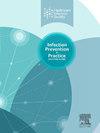Intrahospital dissemination of multidrug-resistant Acinetobacter baumannii at a teaching hospital in Northeast of Mexico
IF 1.9
Q3 INFECTIOUS DISEASES
引用次数: 0
Abstract
Background
Acinetobacter baumannii is an opportunistic drug-resistant Gram-negative coccobacillus associated with nosocomial infections, representing a worldwide public health problem.
Aim
The aim of this study was to analyse the dissemination of A. baumannii in two hospital buildings in Mexico through phenotypic and genotypic characterization of clinical isolates obtained for three years.
Methods
Clinical strains were collected from two buildings in a tertiary-care hospital in Monterrey, Mexico. After species identification by MALDI-TOF MS and PCR, antimicrobial susceptibility was determined by disk diffusion and microdilution methods, carbapenemase-encoding genes (OXA-23, -24, -51, and -58) were searched, and clonal diversity was analysed by PFGE and MLST.
Findings
Among 204 specimens, 87.3% and 50.5% of the isolates were classified as multidrug-resistant (MDR) and difficult-to-treat-resistant (DTR), respectively. The OXA-24 gene was detected in 95% of the isolates. Most isolates (n=181) were grouped into 15 clones, four which predominated and disseminated after five months. Among ST detected (ST1694, ST758, ST124, and ST490), ST124, which belongs to the high-risk CC636 clonal complex, is reported for the first time in Mexico.
Conclusions
Long-term persistence and dissemination of A. baumannii clones were observed in specific hospital wards from two buildings in a tertiary-care hospital in Mexico. High antimicrobial resistance, such as MDR and DTR, were observed in this hospital. DTR surveillance and early recognition of MDR A. baumannii clones should be performed routinely to prevent their dissemination.
墨西哥东北部某教学医院耐多药鲍曼不动杆菌的院内传播
鲍曼不动杆菌是一种与医院感染相关的机会性耐药革兰氏阴性球菌,是一个全球性的公共卫生问题。目的通过对三年来获得的临床分离株进行表型和基因型分析,分析鲍曼不动杆菌在墨西哥两所医院的传播情况。方法从墨西哥蒙特雷某三级医院的两栋楼采集临床菌株。采用MALDI-TOF MS和PCR鉴定菌种,采用纸片扩散法和微量稀释法测定药敏,筛选碳青霉烯酶编码基因OXA-23、-24、-51和-58,采用PFGE和MLST分析克隆多样性。结果204份标本中,87.3%为耐多药(MDR), 50.5%为难治耐药(DTR)。95%的分离株检测到OXA-24基因。多数分离株(n=181)分为15个无性系,其中4个无性系在5个月后占优势并播散。在检测到的ST (ST1694、ST758、ST124、ST490)中,ST124属于高危的CC636克隆复合体,在墨西哥首次报道。结论在墨西哥一家三级医院的两座建筑物的特定病房中观察到鲍曼不稳定杆菌的长期存在和传播。该院观察到耐多药、DTR等高抗菌药物耐药性。应常规进行DTR监测和早期识别耐多药鲍曼杆菌克隆,以防止其传播。
本文章由计算机程序翻译,如有差异,请以英文原文为准。
求助全文
约1分钟内获得全文
求助全文
来源期刊

Infection Prevention in Practice
Medicine-Public Health, Environmental and Occupational Health
CiteScore
4.80
自引率
0.00%
发文量
58
审稿时长
61 days
 求助内容:
求助内容: 应助结果提醒方式:
应助结果提醒方式:


